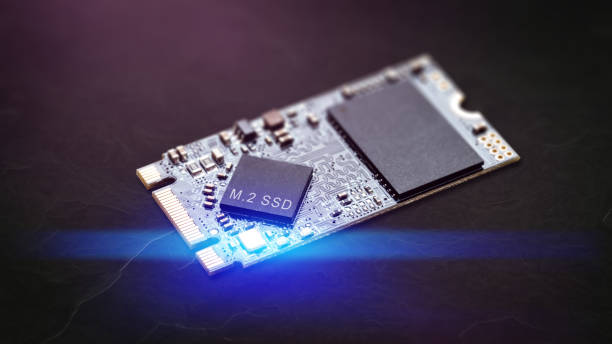Solid-State Drives (SSDs) have revolutionized data storage by offering faster speeds, improved reliability, and efficient power consumption compared to traditional hard drives. This article delves into the evolution of SSDs, from their early developments to their current state-of-the-art implementations, and forecasts for future advancements.
Early Developments in SSD Technology

The inception of SSD technology dates back to the 1950s when early forms of solid-state storage were used in military and space applications. These initial devices, known as “”bubble memory,”” utilized magnetic domains in a thin film of magnetic material to store data. Though groundbreaking at the time, they were limited by low storage capacity and high costs.
In the 1980s, advancements in semiconductor technology led to the development of NOR and NAND flash memory. NOR flash offered quicker read speeds, while NAND flash provided higher density and lower costs, becoming the foundation for modern SSDs. Despite these strides, SSDs remained expensive and were primarily used in niche markets and high-performance computing environments.
The Rise of Consumer SSDs
By the mid-2000s, the decreasing cost of NAND flash memory and increased production efficiency allowed SSDs to enter the consumer market. SSDs offered significant advantages over traditional Hard Disk Drives (HDDs), including higher read/write speeds, greater durability due to the lack of moving parts, and lower power consumption.
Manufacturers such as Intel, Samsung, and Kingston began to release consumer-grade SSDs, marking a significant turning point in SSD adoption. These drives provided a notable performance boost for everyday computing tasks, gaming, and professional applications, thus attracting a broader audience.
Advancements in SSD Performance
The continuous innovation in SSD technology has led to remarkable improvements in performance. Modern SSDs leverage the latest advancements in NAND flash memory, controllers, and firmware to achieve faster data transfer rates and enhanced reliability.
Additionally, the introduction of Non-Volatile Memory Express (NVMe) protocol has significantly boosted performance by reducing latency and increasing input/output operations per second (IOPS). This protocol allows SSDs to make better use of the high-speed PCIe interface, which is more efficient than the older SATA interface.
Today, SSDs can achieve sequential read and write speeds exceeding 3,000 MB/s, making them an ideal choice for demanding workloads and high-performance computing applications.
Impact on Data Storage Solutions
The widespread adoption of SSDs has had a profound impact on data storage solutions across various industries. SSDs are now commonly used in data centers, enterprise environments, and personal computing to enhance performance and reliability.
Data centers benefit from the reduced power and cooling requirements of SSDs, which translate into lower operational costs and higher efficiency. In enterprise settings, SSDs enable faster access to critical data, thus improving overall productivity and system responsiveness.
On the consumer front, SSDs have become a standard in modern laptops, gaming consoles, and desktops, providing users with an unparalleled computing experience. The growing popularity of SSDs has also spurred innovation in hybrid storage solutions, such as combining SSDs with HDDs to balance performance and storage capacity.
Future Trends and Predictions for SSD Technology
The future of SSD technology looks promising, with ongoing research and development efforts aimed at pushing the boundaries of storage capacity, performance, and affordability. Emerging technologies such as 3D NAND and QLC (Quad-Level Cell) NAND are expected to drive further advancements in SSDs.
3D NAND involves stacking multiple layers of memory cells vertically, thereby increasing storage density and reducing costs. QLC NAND allows each memory cell to store four bits of data, further driving down costs and increasing capacity.
Moreover, the development of next-generation interfaces such as PCIe 5.0 and advancements in NVMe protocols are poised to unlock even greater performance levels. As technology continues to evolve, SSDs will likely become more accessible, offering higher capacities and blazing-fast speeds at lower prices.
Conclusion
The evolution of Solid-State Drives (SSDs) has transformed the landscape of data storage, offering unparalleled speed, reliability, and efficiency. From their early beginnings to the cutting-edge technology available today, SSDs have continually pushed the boundaries of what is possible in storage solutions.
As we look to the future, SSD technology is set to evolve further, driven by innovations in NAND flash, advanced protocols, and next-generation interfaces. Whether for personal use, enterprise applications, or data centers, SSDs will remain a cornerstone of modern computing.
FAQs
What is the primary advantage of SSDs over HDDs?
The primary advantage of SSDs over HDDs is speed. SSDs offer significantly faster read and write speeds, resulting in quicker boot times, faster file transfers, and enhanced overall system performance.
How has the cost of SSDs changed over time?
The cost of SSDs has decreased significantly over time due to advancements in NAND flash technology and increased production efficiencies. This has made SSDs more accessible to consumers and businesses alike.
What are the key components of an SSD?
The key components of an SSD include the NAND flash memory, which stores data, and the controller, which manages data access and performance. Additional components may include DRAM cache for temporary data storage and firmware that optimizes drive operations.
Can SSDs be used in data centers?
Yes, SSDs are widely used in data centers due to their high performance, reliability, and lower power consumption. SSDs help improve data access speeds and reduce operational costs, making them ideal for data-intensive applications.
What future technologies could impact SSD evolution?
Future technologies that could impact SSD evolution include 3D NAND, QLC NAND, and new interfaces like PCIe 5.0. These advancements are expected to increase storage capacities, enhance performance, and reduce costs, further transforming the SSD landscape.


